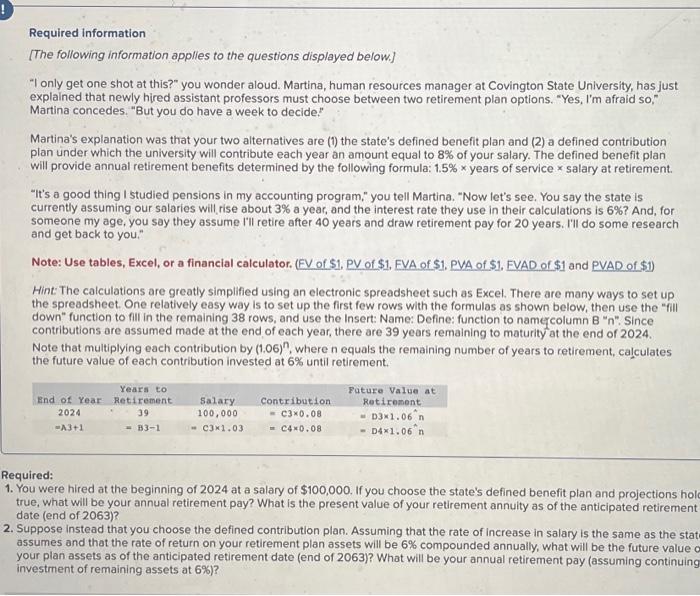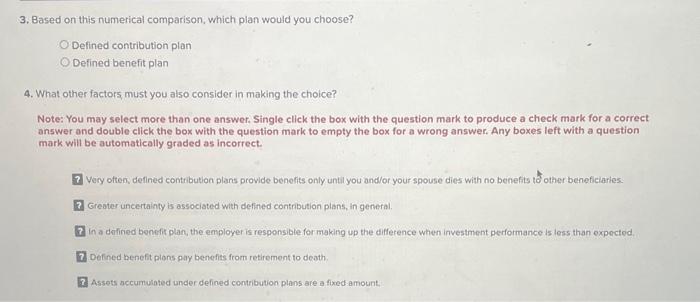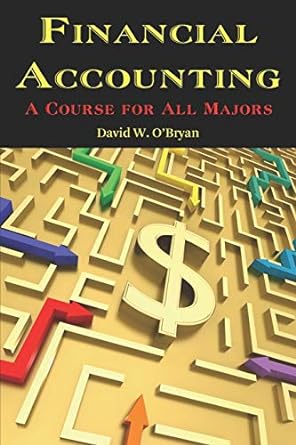Required information [The following information applies to the questions displayed below.] "I only get one shot at this?" you wonder aloud. Martina, human resources manager at Covington State University, has just explained that newly hired assistant professors must choose between two retirement plan options. "Yes, I'm afraid so," Martina concedes, "But you do have a week to decide." Martina's explanation was that your two alternatives are (1) the state's defined benefit plan and (2) a defined contribution plan under which the university will contribute each year an amount equal to 8% of your salary. The defined benefit plan will provide annual retirement benefits determined by the following formula: 1.5% years of service salary at retirement. "It's a good thing I studied pensions in my accounting program," you tell Martina. "Now let's see. You say the state is currently assuming our salaries will rise about 3% a year, and the interest rate they use in their calculations is 6% ? And, for someone my age, you say they assume l'll retire after 40 years and draw retirement pay for 20 years. I'll do some research and get back to you." Note: Use tables, Excel, or a financial calculator. (EV of \$1, PV of $1, EVA of $1, PVA of $1, EVAD of $1 and PVAD of $1 ) Hint: The calculations are greatly simplified using an electronic spreadsheet such as Excel. There are many ways to set up the spreadsheet. One relatively easy way is to set up the first few rows with the formulas as shown below, then use the "fill down" function to fill in the remaining 38 rows, and use the Insert: Name: Define: function to namercolumn B "n". Since contributions are assumed made at the end of each year, there are 39 years remaining to maturity at the end of 2024. Note that multiplying each contribution by (1.06)n, where n equals the remaining number of years to retirement, calculates the future value of each contribution invested at 6% until retirement. Required: 1. You were hired at the beginning of 2024 at a salary of $100,000. If you choose the state's defined benefit plan and projections hol true, what will be your annual retirement pay? What is the present value of your retirement annuity as of the anticipated retirement date (end of 2063)? 2. Suppose instead that you choose the defined contribution plan. Assuming that the rate of increase in salary is the same as the stat assumes and that the rate of return on your retirement plan assets will be 6% compounded annually, what will be the future value your plan assets as of the anticipated retirement date (end of 2063)? What will be your annual retirement pay (assuming continuing investment of remaining assets at 6% )? You were hired at the beginning of 2024 at a salary of $100,000. If you choose the state's defined benefit plan and projections hold true, what will be your annual retirement pay? What is the present value of your retirement annuity as of the anticipated retirement date (end of 2063)? Note: Round your answers to the nearest whole dollar amount. Do not round your intermediate calculations. Suppose instead that you choose the defined contribution plan. Assuming that the rate of increase in salary is the same as the state assumes and that the rate of return on your retirement plan assets will be 6% compounded annually, what will be the future value of your plan assets as of the anticipated retirement date (end of 2063)? What will be your annual retirement pay (assuming continuing investment of remaining assets at 6% )? Note: Round your answers to the nearest whole dollar amount. Do not round your intermediate calculations. Tahle 1 Fature value of 41 TNEted Frestat qahe of 51 JxBe t Funure Yabie of as Oratisary k snulty of $1 Table 9 twere Value of an Annuliy the of 51 3. Based on this numerical comparison, which plan would you choose? Defined contribution plan Defined benefit plan 4. What other factors must you also consider in making the choice? Note: You may select more than one answer. Single click the box with the question mark to produce a check mark for a correct answer and double click the box with the question mark to empty the box for a wrong answer. Any boxes left with a question mark will be automatically graded as incorrect. Very often, defined contribution plans provide benefits only until you and/or your spouse dies with no benefits t other beneficiaries. Greater uncertainty is associated with defined contribution plans, in general. In a difinied bencfit plan, the employer is responsible for making up the difference when investment performance is less than expected Defined benefit plons pay benefits from retirement to death Assets accumulated under defined contribution plans are a fixed amount
















